HOWSCARUM: A Primer for Running Horror RPGs
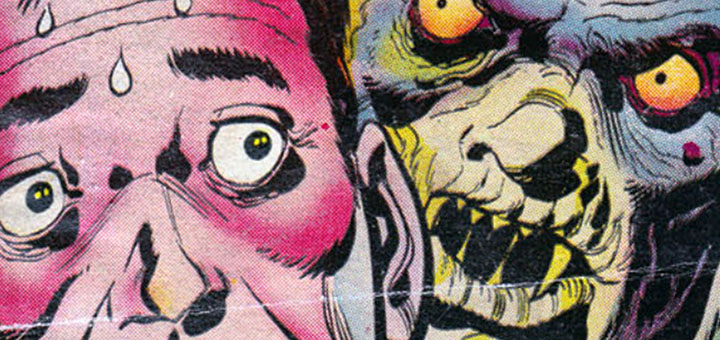
This is a practical guide to scaring your players.
It is very much not a lyrical ode to horror fiction, an odyssey into the gloomy alcoves of the human soul, or an index of psychic pressure points. For these ventures you’ll want an artistic guide to scaring your players, which in my years of taking and giving horror RPG advice I have encountered in great quantity and varying quality.
Instead, my concerns are matters of technique and tablecraft: mundane, straightforward tools which may be applied easily and consistently. If your goal is to create fear and suspense through collaborate storytelling, these concerns are critical. It’s my firm belief that a stunningly creative horror game run poorly will have far less impact than a bland, derivative premise which is executed confidently.
To demonstrate this belief, I’ll illustrate all of my strictly-practical do-and-don’t examples with genre trash—the most basic Halloween-store garbo you can think of. We’re looking at zombies with ripped pants, spooky scary skeletons, and serial killers with sports masks. Because, again, I’m not here to teach you how to create the creepiest thing possible. I’m here to show you how to use what you create in a basically effective fashion.
But first, let’s talk…
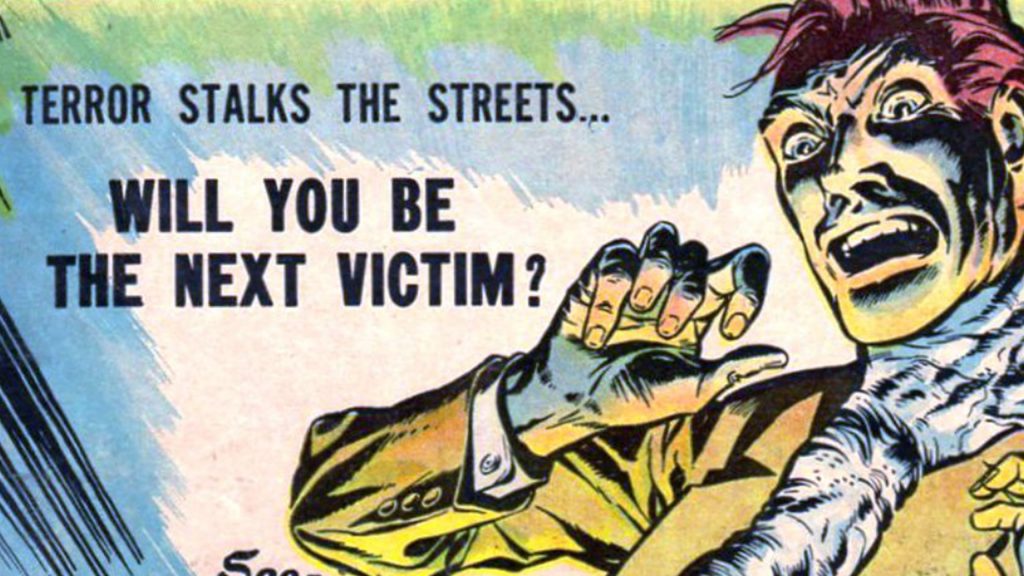
Who’ll Enjoy Horror?
I have no advice for making players interested in a horror game. This guide presumes your players are receptive to being frightened and would enjoy having it done to them. In other words:
- They enjoy dread, suspense, and panic.
- They’re secure enough to be vulnerable in front of a group. When a GM complains their players “don’t take horror seriously,” that often secretly means: “My players are uncomfortable performing unease, fright, and helplessness in front of their peers.” Which is pretty common, and also, totally fine. Apocalypse World literally lets them take an ability called NOT TO BE FUCKED WITH; why not play that instead?
- They’re in the mood for it. Read the room. If everyone just got off murder shifts and somebody’s cat died, maybe don’t pull out Bluebeard’s Bride. Try something happy instead.
If you’re sizing up your group, I find a great place to start is asking: “Do you want to play a scary game?” You’d think it’d be an obvious question, but then you hear GMs griping about uncooperative players when they never bothered to advertise their game’s genre or even check that it was in demand.
If you get your group on board, great! Schedule the game out special, play some creepy music, dim the lights, and otherwise make people feel this session’s something a little more involved than board game night. You’ll set the mood, but more importantly, tell your players you are putting yourself out there to create a special experience. As a player, trying to get immersed in a horror game and ultimately frightened puts one at risk of embarrassment or frustration; knowing that the GM is assuming these risks first will make them feel more comfortable.
So now your game’s starting. That means you’ll need to be especially aware of…
Basic Structure and Pacing
GM: Cassidy, you’re a parking booth operator. It’s a chipper, bright summer’s afternoon, and an ice cream truck is pulling around the corner.
CASSIDY: Cool. I’ll wander over and order a–
GM: A man in a bloody boiler suit jumps out of the back with a machete!
CASSIDY: …Oookay. Roll initiative, right?
This obviously isn’t very scary.
You might be tempted to plan your horror session in terms of what I call the action: the moments where something outright scary is happening. If you’ve played a fun horror session, the action is probably what you remember years later. You might even be forgiven for thinking that action is the only “horror” part of a horror game.
But especially when you’re starting out, it’s good to consider action not as the narrative but as the endpoint of a narration sequence. Action is scariest when the players have been dreading it, sure something bad is going to happen and sort of (but not totally!) knowing what it will be. In a word, when it’s foreshadowed. And foreshadowing best captures a player’s imagination when something else already made them anxious but did not give them a specific outlet for it; in other words, when there’s vague but unsettling portents.
String these three elements together and you have a functional unit for building horror sessions:
- Portents make players nervous.
- Foreshadowing directs those nerves to something specific, turning them into fear.
- Action validates their fear, creating fright and ensuring they’ll be even more scared next time.
A sequence might be completed over the course of an entire session, where a single action is foreshadowed dozens of times against a wealth of related portents, or you might complete an entire sequence within a minute and three narrations. You might cycle from one sequence to another or juggle several at a time, presenting looming threats on multiple fronts. Part of the reason players don’t become bored of this sequence is that you have an excellent degree of flexibility in how you use it. The closest thing to a hard-and-fast rule I’d offer is that, as the session progresses, your sequences should escalate: the portents should grow more ominous, the foreshadowing more sinister, the actions more overt and lethal.
If you’re just starting out, sequences are an invaluable GMing tool. I’d even recommend recording yours on scratch paper: writing down the portents and foreshadowing you use, making notes of action you’d like to work up to and sketching in how you might get there.
Let’s try our first example again, but this time, we’ll use a sequence. Since it’s the start of the session, we’re not going to escalate immediately into “attack of the slasher.” Instead we’ll work up to a more modest action: “the guy who runs the ice cream truck shows up and he’s really unsettling.”
GM: Cassidy, you’re a parking booth operator. It’s a chipper, bright summer’s afternoon, and an ice cream truck is pulling around the corner.
CASSIDY: Cool. I’ll wander over to order something.
GM: A maintenance guy is already in line. You see there’s a couple kids standing on the corner, fiddling idly with their bikes. Though the music’s playing, they’ve all turned their backs to the truck.
CASSIDY: Huh. That’s odd. Well, I get in line.
GM: The maintenance guy has reached the front, but after a conversation you can’t hear, he says something and turns around. As he walks away, he meets your eye and gives a quick shake of his head. He mouths something you don’t quite make out. From the window a voice suddenly bellows out: “Next!”
CASSIDY: Okay, this feels sketchy. I’m just gonna give an “I’m good” gesture at the window–
GM: The ice cream man is staring at you. His eye is swollen, his nose is broken and streaming blood.
CASSIDY: I walk away immediately.
GM: Do you go back to your booth?
CASSIDY: Uh…yes.
GM: Okay. As the sun beats down, and five, ten, twenty minutes pass, the truck’s still sitting there on the corner, and without a single customer…
First the kids weren’t getting ice cream; that sets off a “something’s not right” vibe, but doesn’t point to anything specific. Then the maintenance guy tries to warn the player, which focuses that vibe: something’s not right with the ice cream truck and its occupant. Finally, the action: he turns out to be a scary dude. Portent, foreshadowing, action. Now we can use the validated unease we’ve painstakingly built up to work on some bigger scares, ideally involving animal masks and chainsaws.
Creating Scary Choices
GM: You’re driving down a lonely road, late at night. Suddenly, your headlights capture a hitchhiker standing on the side of the road.
ALEX: (shaking head) Yeah, okay. I pull over.
If you’re reading a book or watching a movie, it’s scary when a character does something really dangerous without knowing it. We want to shout a warning, but can’t; this is a popular and effective way to generate unease and anxiety in a genre-savvy audience.
It doesn’t work like that in horror RPGs.
This is partially because—in a very real sense—we can shout a warning to our characters. We just have to choose not to, and that’s not anxiety-provoking, it’s just kind of frustrating. Worse: it’s immersion-breaking.
Immersion is not important in every genre of roleplaying, but for any horror game that isn’t very conceptual, it’s critical. It’s hard to be scared by a game where you aren’t at least mostly putting yourself in your character’s shoes. Should you oblige players to do something they know is dangerous just because their character wouldn’t, you’re highlighting the disconnect in their emotional states. You’re making the player a witness to the horror, a co-author, when they should be a participant.
This is not the same as saying “don’t oblige player characters to do scary, horror-movie stuff.” On the contrary, you should: no terror is felt more strongly than the one that seems self-inflicted. The key is that players shouldn’t be going along with it for the sake of being a good sport, or seeing what happens next. They shouldn’t know better than their characters. On the contrary: the characters should also be scared.
If you’ve got strong roleplayers in your group, people who are very good at feeling what their characters feel, you can take advantage of motivations stronger than their character’s fear of death. They might go into danger to save a family member, or find out the answer to a mystery that’s plagued them their whole lives, or even for profit. But the easiest and most universally applicable way to make your players do dangerous stuff is to put them in charged situations where every choice is scary or dangerous; where the shadows ahead are matched only by the shadows before and between.
Instead of making players pick up a hitchhiker, let’s try this:
GM: After your car rolled into a ditch, you’ve been walking a lonely road late at night. For an hour your phone has had zero bars, and soon, it’ll be dead. You’re starting to feel tired when you see a pair of headlights flicker around the bend in the pines.
ALEX: I…geez. I guess I stick my thumb out.
Alex obviously recognizes this is the start of a really messed up campfire story. But crucially, so does Alex’s character. Both feel nervous about flagging down a stranger’s car, but is it any less eerie to wander around the darkness in the dead of night? Alex gets to be immersed in-character and has to do something scary. Lucky Alex!
If you really want to keep your players guessing, you can feel free to have the danger be something other than the obvious thing you’d expect (eg, the driver’s normal but the radio or trunk or gas station attendants are creepy). Or you can do exactly what the player and character would expect and validate that they felt nervous about it. Remember, subverting expectations only works if those expectations exist in the first place.
Creating Urgency, Part 1: Craft of Narration
GM: As the groans and chain-clatters reach a macabre crescendo, you skid around the corner. There is the rotting wallpaper; there, the heavy oaken door. You stand at the entrance to the cellar!
YANCY: Aw, dang it. I thought I was going the opposite way. Well, I turn around to run…
GM: Standing before you is a pale and frightful illumination. In every line of its ancient face you see malice twisting and curling. It has no teeth, long fingernails, and a heavy chain in its fists that it grips tightly. As it opens its terrible mouth, releasing a noxious corpse-smelling breath, a wailing rises!
YANCY: (after a beat) Right, I’ll turn and run into the cellar.
The moment Yancy turned the corner and found themselves at the cellar door was supposed to be startling, and the sudden appearance of the ghost was supposed to inspire excitement and terror. So why did Yancy respond so restively both times?
Simple. When players and GMs exchange narration, they’re conveying more than just details of a scene. They’re conveying a sense of time and movement.
Yancy was supposed to be scared by the sudden appearance of the cellar, and then the ghost, but a big part of that fear is that it’s sudden. The appearance of the dreaded, whispering, evil door they were trying to avoid should hit like a slap in the face. The ghost coming up the hall is a real, moving threat that needs to be run from immediately. For these moments to hit right, they must feel as immediate to the player as they would to the character.
When you describe a scene elaborately, starting from broad strokes and filling in details, this has two subtle effects. Firstly, you imply that the player’s character is stopping to regard the thing so carefully and thoroughly that these details would each be cataloged. Especially in the case of the ghost, this isn’t appropriate; no more than a few details would leap out at a person confronted with such an unexpected, urgent sight.
The other effect is that simply by narrating at length, you shift the player from an actor to an observer; you gently nudge them into a seated position while you, the storyteller, paint a picture.
In an urgent situation, this is just what you do not want to do. When the action is picking up you don’t want them on their laurels; you want them at the edge of their seat. You want to make it clear that time is passing quickly, and that they should respond quickly or else be overtaken. Your very narrations must place characters within the moment.
When a situation is charged, and things might develop at any moment, do not narrate elaborately. Respond, briefly and concisely. When they answer, pass the ball back as quickly as you can; force the player to stay reactive. In a tight situation, a quick line that forces a player to act and leaves the details to a panicking imagination is more effective than a paragraph of description.
GM: The groans and clatters are rising behind you. There’s a corner ahead.
YANCY: I turn it.
GM: You almost run into the dark, rotting cellar door.
YANCY: What? Oh, no, I turn back to the hall…
GM: A pale withered man stands there. He shrieks...
YANCY: I run into the cellar!
If you love elaborate descriptions, good news! They’ve most certainly got a place in the game. If you save ’em up for when a character is trapped, hiding, or confronted with something scary but not actively hostile, you can really impress upon the players a sense of being helpless or fascinated by a terrible presence. How frequently you oblige a player to respond should be dependent on whether you want them to feel on the spot and desperate or overwhelmed and not in control; in a really good session, you’ll probably need snappy and longer descriptions to suit changing scenarios.
Creating Urgency, Part 2: The Q&A Session
GM: You race into the supply closet and slam the door shut. You don’t think the zombies are far behind.
JORDAN: Oh, geez. I guess I should barricade? Are there, like, mops?
GM: Yes, two mops.
JORDAN: Are they sturdy-looking?
GM: Not specially? They’re normal mops.
JORDAN: But like wood or plastic?
GM: Wood.
JORDAN: I guess I could duct-tape those to the door to keep it from swinging in?
TONI: Why not just hit them with the mops?
JORDAN: Naw, come on, there’s probably a better melee weapon in there.
TONI: Oh, fair.
JORDAN: That’s a good point, though. Do I see any hammers?
GM: No hammers.
JORDAN: Hm…how about anything sharp? Screwdrivers? Or, uh…
PENNY (showing Google search on phone): Check for…these three common chemicals.
JORDAN: Oh, nice. Do I see any cleaners or enclose-able containers?
This isn’t scary, though it’s probably a perfectly fun session. You’ve clearly impressed on them how dangerous the situation is if they’re asking so many questions, and it’s often enjoyable to to explore options with other players and find ways to tackle problems together. But the danger’s not scary because it lacks urgency; the zombies might be right at the door, but it feels like they’ll wait around all day while the players put together an inventory of improvised weapons and barricades.
This is a very common problem in horror games. The more frightened players feel, the more they’ll seek effective solutions to the threats they’re afraid of. As their search for solutions drags on past a reasonable point, the sense of urgency bleeds out and the fright is lost. Your goal is to avert this self-braking loop and preserve a sense of momentum and panic while also providing the information players need to take action, find good details, and develop the story.
You will need to counter an instinct that most players develop: that only taking explicit in-character action will move time forward and allow a peril to escalate. Since most games are rooted in contemplative tactics and storytelling, this is a very natural feeling, but if your players are in a situation you want to feel active and sincerely dangerous, I recommend you observe these guidelines:
- When a player asks a question their character might be able to answer…
- If the answer is right there and very obvious, respond simply and completely. Giving a straight and comprehensive answer means they’re less likely to ask a follow-up question. If you can see where they’re going with it, you can even add an equally obvious follow-up answer: “The room was lit by lamps. You don’t remember where the switch was in this room.“
- If the answer is accessible but not immediately obvious—eg, something their character would have to look around to spot or take a moment to recall—give them the answer, but immediately follow it up with a quick and unsolicited update on the looming danger. This can just be a reminder that the danger exists, a footstep or a groan or rats fleeing a burning room, or it can be an actual (or implied) escalation: footsteps getting closer, moans getting louder, the fire spreading to the rug the character stands on.
- If the answer is too hard to get—eg, it’s beyond the character’s perception or recollection—allude to this while also narrating something that reminds them they’re in trouble. “You pull the book off the shelf and start flipping through the hundreds of Latin pages as the flames race up the curtains…”
- When a player offers another (or is asked for) advice about a danger…
- If they have a character present (ie, they’re also in danger), follow the same principles as above. Every so often, develop the peril to make it clear you won’t freeze time while their characters talk things through.
- If they don’t have a character present, immediately bring the focus of the game back to the person who does with a snappy question or narration that puts them on the spot. Pointing at the player whose attention you’re reclaiming is a good, if somewhat direct, approach. (It also can be useful in non-urgent situations where you’re trying to get people back on track, but use it responsibly. Don’t be rude and demanding of your players; at the end of the day, you’re all hanging out with friends.)
- If they pause for too long…
- If they’re having fun, but are just taking too long to think over their options, make it clear that game time hasn’t stopped by narrating periodic escalations. Alternately, put them directly out of their indecision and just make the danger manifest. They might even be grateful.
- If you suspect they might actually be frozen up in real life and not having a good time, do the opposite of everything else I talked about. Find a way to relieve the pressure: cut away or find an excuse for the peril to move on. As always, know your group and distinguish being a good horror GM from being an outright sadistic one.
Let’s try the example again, this time controlling information and escalations in a way that keeps the momentum of the scene going.
GM: You race into the supply closet and slam the door shut. You don’t think the zombies are far behind.
JORDAN: Oh, geez. I guess I should barricade? Are there, like, mops?
GM: You see a few mops in the corner. Through the door, you hear the mob gibbering and shuffling…
JORDAN: I put my back to the door. Are the mops sturdy-looking?
GM: It’s two squat, wooden mops.
JORDAN: I guess I could duct-tape them to the door to keep it from swinging in?
TONI: Why not just hit them with the mops?
GM: BAM! (points at Jordan) You feel the door rock against your shoulders. It feels like it could go at any moment.
JORDAN: Oh, uh, I grab the mops and press them against the door.
GM: You get them up there, but how do you tear off duct tape while pressing the door shut?
JORDAN: Geez, uh…um…
GM: BAM!
Developing Your Skills
The four practices I’ve discussed are the pillars of my technique. Following them has given me some unforgettable moments, to say nothing of my players, who have—on various happy occasions—screamed, turned pale, and literally jumped at shadows.
It’s my hope you’ll find my advice useful, and that if you have any questions, you’ll ask them. But I feel I should end by boiling my advice down to a single and central principle:
Horror is not something you create and then serve. It’s something you and your group create together. Your goal is not to dream up the craziest thing you can and then run through a script perfectly; it’s to respond to your players’ moods and level of tension appropriately, building productive emotional loops and averting ones which are not productive. Above all else, a good horror GM is one who knows how to manage a table effectively.
Don’t have a good horror system? I designed a very simple but effective set of mechanics which are easily adapted to any genre of scary fiction called The Evil. The full, free rules are available here.

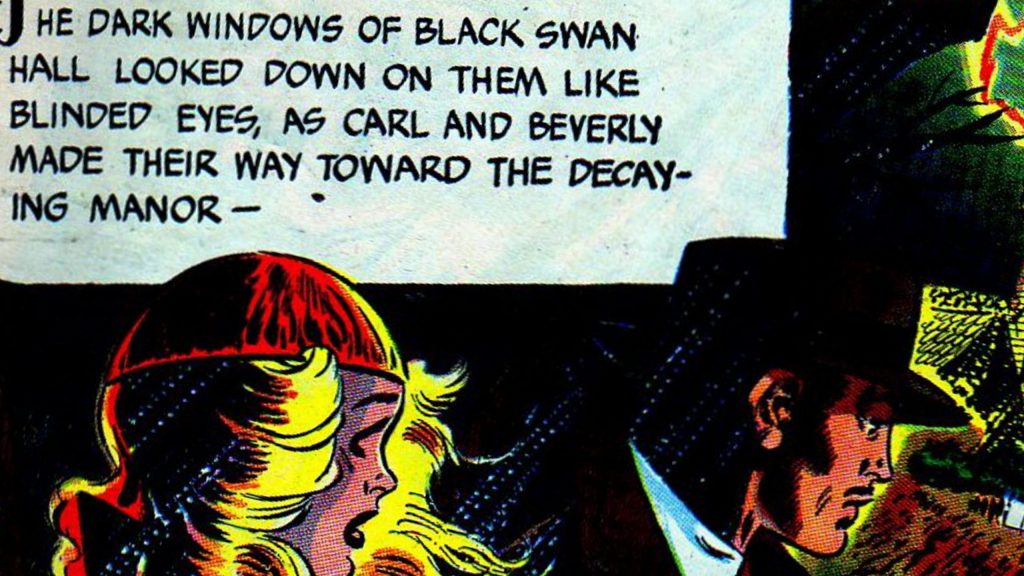
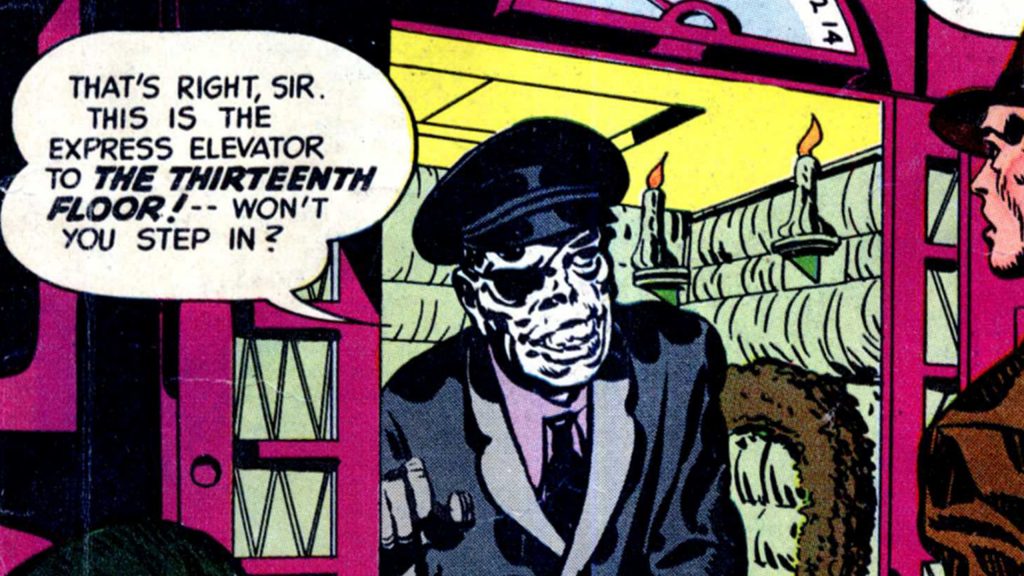
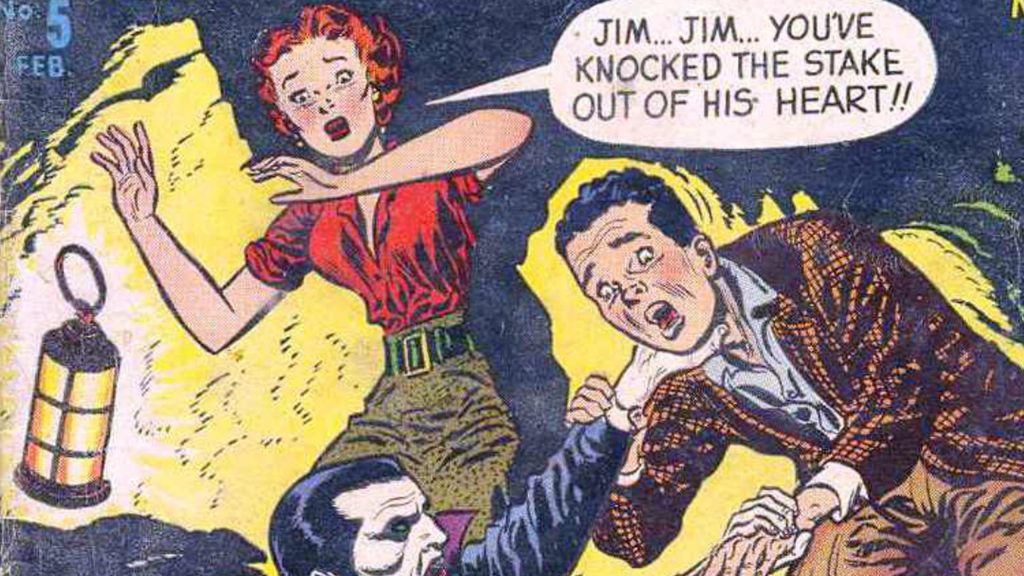
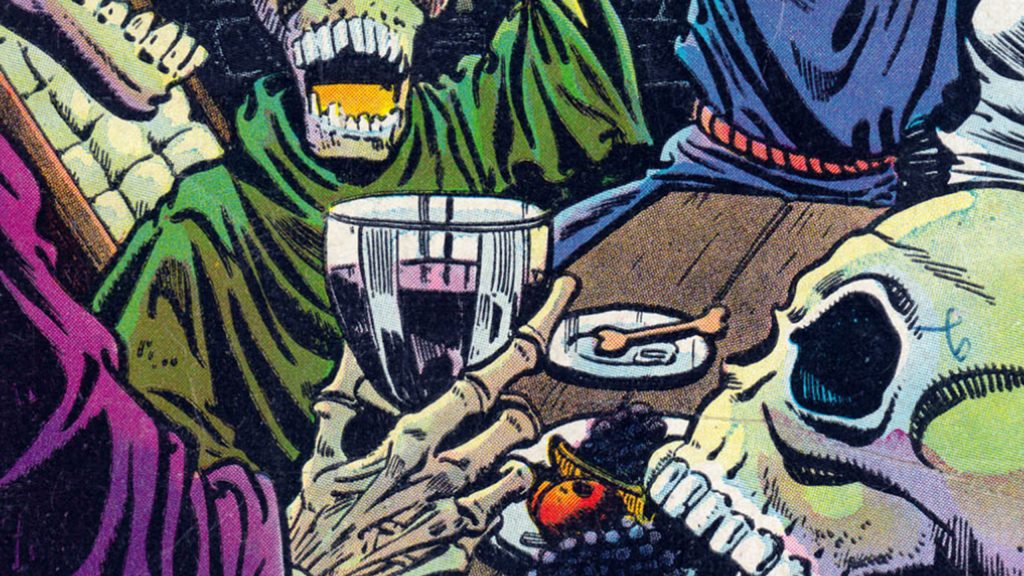
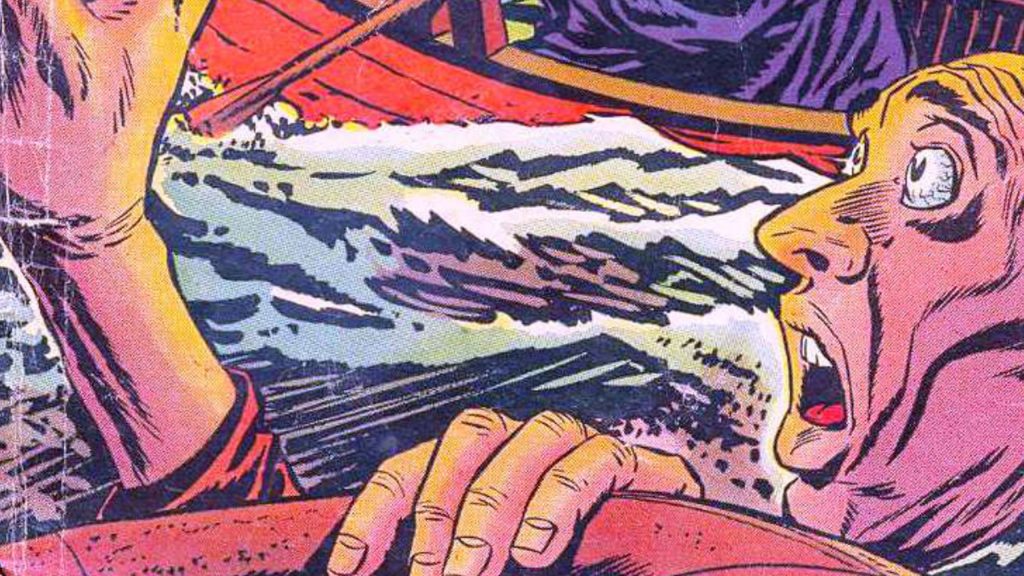

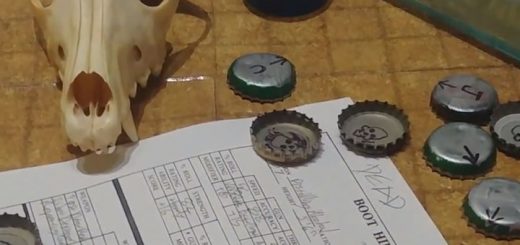



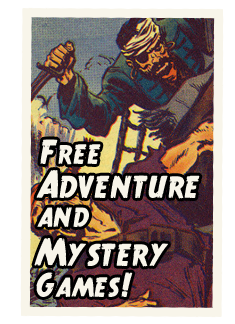
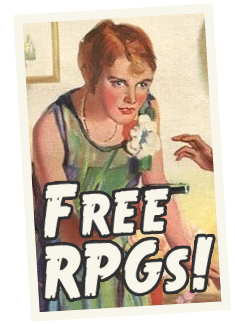
Art Credits:
Weird Terror, March 1953. Artist: Don Heck.
Web of Evil, October 1953. Artist: Jack Cole.
Weird Horrors, October 1953. Artist: Joe Kubert.
Black Magic, October 1952. Artist: Jack Kirby.
Chamber of Chills, February 1952. Artist: Lee Elias.
Fantastic Fears, November 1053. Artist: Thought to be Iger Shop.
Adventure into Darkness, June 1954. Artist: Thought to be Ross Andru.
Good read! Not sure if my group is intense enough to do a horror campaign, but will definitely need to revisit this if we decide to do one.
Tangentially related, are you planning to post the mechanics for “The Evil” on this blog? I’ve had multiple friends ask me to share it with them and it’d be nice if I could do that in a way that links back to you.
Hakura: You know what? Good idea. Enjoy.
http://www.chocolatehammer.org/?page_id=6065
This is great! I’m sure I’ll find good use for this soon. Incidentally, The Evil was a hit as the basis of a cosmic horror game I ran on Halloween, thanks for putting it out there.
Also, I love the vintage comic art as a website motif, and especially here.